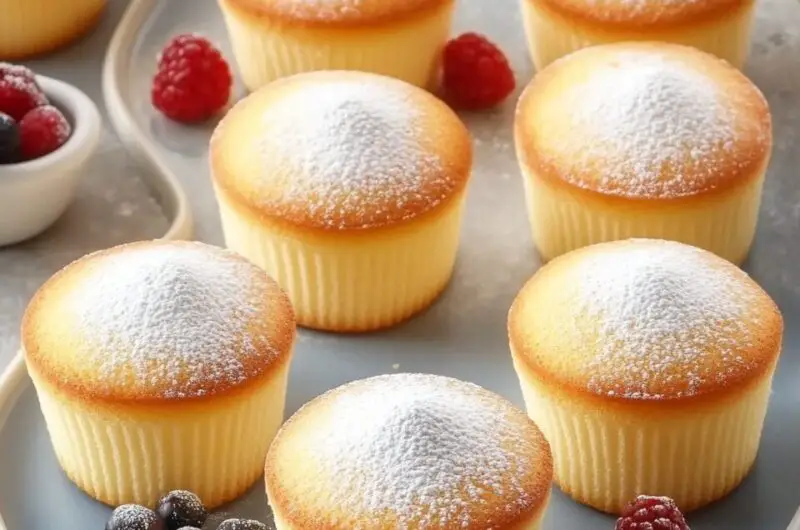These Mini Sponge Cakes are a timeless classic brought to life in petite form. With a light, airy texture and just the right amount of sweetness, these cakes are perfect for an elegant afternoon tea or a simple family dessert. Their golden tops dusted with powdered sugar give them a nostalgic charm, while the soft interior melts in your mouth with every bite. Whether served alone, with a dollop of whipped cream, or adorned with fresh berries, these mini sponge cakes are versatile and crowd-pleasing. They’re also wonderfully easy to make, using just a few pantry staples. Perfect for beginner bakers or seasoned pros looking for a quick yet impressive dessert, these cakes make any day feel like a celebration.
Full Recipe:
Ingredients:
-
1 cup all-purpose flour
-
1/2 cup granulated sugar
-
4 large eggs
-
1 tsp vanilla extract
-
1/4 tsp salt
-
1/2 tsp baking powder
-
1/4 cup milk
-
Powdered sugar for dusting
-
Whipped cream and fresh berries (optional for topping)
Directions:
-
Preheat your oven to 350°F (175°C). Lightly grease or line a mini cake pan or muffin tin.
-
In a large bowl, beat the eggs and sugar together until pale, thick, and tripled in volume.
-
Gently fold in the vanilla extract, then sift the flour, salt, and baking powder together and gradually fold it into the egg mixture.
-
Heat the milk slightly and mix it in slowly, being careful not to deflate the batter.
-
Spoon the batter into your prepared tins and bake for 12–15 minutes, or until a toothpick comes out clean.
-
Let cool slightly, then transfer to a wire rack. Dust with powdered sugar and top with whipped cream and berries if desired.
Prep Time: 10 minutes | Cooking Time: 15 minutes | Total Time: 25 minutes
Kcal: 145 kcal | Servings: 6 mini cakes
The Delight of Mini Sponge Cakes: A Light and Elegant Dessert for Every Occasion
Mini sponge cakes are a delightful culinary treasure that captures the essence of classic baking in a smaller, more refined format. Light, airy, and subtly sweet, these cakes are cherished by dessert lovers around the world. With origins rooted in traditional sponge cake recipes, the mini version offers a charming and versatile option for serving at tea parties, brunches, birthdays, or as a simple treat after dinner. Their compact size and tender texture make them a favorite for those seeking elegance and portion control without sacrificing flavor.
Whether topped with powdered sugar, paired with fresh fruit, or layered with whipped cream, mini sponge cakes bring a timeless quality to the dessert table. Their soft, pillowy consistency and golden color are a testament to the art of baking with just a handful of ingredients done right. This article dives deep into the appeal, history, variations, and tips for perfecting mini sponge cakes, making it a valuable addition to your food blog or recipe website.
A Brief History of Sponge Cakes
Sponge cakes have a long and storied history, tracing back to the Renaissance period. Believed to have originated in Europe, particularly in regions like Italy and Spain, sponge cakes evolved over the centuries to become a foundational component of Western baking. One of the earliest known recipes for sponge cake appears in the 1615 book The English Huswife by Gervase Markham, which outlined the method of whisking eggs and sugar until frothy before adding flour.
The modern sponge cake is primarily known for its airy structure, achieved without the use of chemical leavening agents. Instead, the cake relies on the aeration of eggs, typically by beating them vigorously with sugar until light and foamy. The mini sponge cake simply takes this iconic dessert and scales it down for convenience and presentation, without losing the delicate nature that defines its charm.
Why Mini Sponge Cakes Are So Loved
There’s something incredibly satisfying about a dessert that looks as good as it tastes. Mini sponge cakes strike that perfect balance between form and function. Here are a few reasons why they continue to win hearts:
1. Perfect for Portion Control
Unlike a large, single-layer cake, mini sponge cakes offer a built-in serving size. This is ideal for anyone watching their portions or those looking for a petite treat that doesn’t overindulge.
2. Beautiful for Entertaining
Mini sponge cakes are a host’s dream. Their individual servings make plating easier and more hygienic, especially for events or buffets. With minimal effort, each guest gets a stunning dessert that feels tailor-made.
3. Versatile Flavor Base
The neutral flavor of sponge cake means it pairs well with a variety of toppings and fillings. Whether you lean towards fruity, creamy, or chocolaty additions, the mini sponge cake provides the perfect base to build upon.
4. Quick and Simple to Make
While it might seem like a fancy treat, sponge cakes are quite simple when you follow the basic technique. The mini version typically bakes faster, making it ideal for last-minute dessert planning.
Serving Ideas and Flavor Variations
Mini sponge cakes offer a blank canvas for creativity. With just a little imagination, they can be transformed into a multitude of delightful desserts suitable for any mood or celebration.
Classic with Powdered Sugar
The most traditional way to enjoy mini sponge cakes is with a light dusting of powdered sugar. It enhances the sweetness and adds a touch of elegance to the already beautiful golden top.
Berry Bliss
Top each cake with a spoonful of whipped cream and a handful of fresh berries strawberries, blueberries, raspberries for a light, refreshing dessert that’s perfect for spring and summer gatherings.
Chocolate Drizzle
For the chocolate lover, a warm drizzle of ganache or chocolate sauce turns the sponge cake into a rich and decadent dessert without making it overly heavy.
Lemon Glaze or Zest
Adding a zesty lemon glaze or a bit of lemon zest gives the sponge cake a citrusy lift, perfect for brunch or afternoon tea. This variation balances the sweetness with a tangy edge.
Filled Mini Cakes
Slice the cakes horizontally and fill them with jam, pastry cream, or a buttercream layer. This makes for a stunning layered dessert that mimics a mini Victoria sponge.
Tips for Perfect Mini Sponge Cakes
Even with a simple recipe, technique matters. Here are some tried-and-true tips to help ensure your mini sponge cakes turn out flawless every time.
Whip Those Eggs Right
The structure of the sponge cake heavily depends on properly aerated eggs. Whip them until they’ve tripled in volume and the mixture forms ribbons when the beaters are lifted.
Sift Your Dry Ingredients
To maintain the delicate structure, always sift your flour and other dry ingredients. This ensures there are no clumps and helps incorporate them more gently into the egg mixture.
Fold, Don’t Stir
When combining wet and dry ingredients, use a light hand. Fold gently with a spatula to avoid knocking out the air that was whipped into the eggs.
Don’t Overbake
Mini cakes bake faster than large ones, so keep a close eye on them. Remove them from the oven as soon as they spring back to the touch and a toothpick comes out clean.
Cool Completely Before Decorating
If you plan to add toppings or fillings, make sure the cakes are fully cooled. This prevents the whipped cream or glaze from melting and ensures the structure holds.
Advertisement
When to Serve Mini Sponge Cakes
These delightful little cakes are incredibly versatile and suitable for many occasions:
-
Afternoon tea gatherings: Their size and elegance fit perfectly on a tiered dessert tray.
-
Birthdays or baby showers: Mini sponge cakes allow for creative decoration without needing a full-sized cake.
-
Dessert buffets: Easy to pick up and serve, they blend beautifully with a spread of other treats.
-
Everyday indulgence: Sometimes, you just want a small sweet treat with your coffee or after dinner.
Storing and Freezing Tips
Mini sponge cakes are best enjoyed fresh, but they can also be stored or frozen if needed.
-
Storage: Keep them in an airtight container at room temperature for up to 2 days. If topped with whipped cream or fruit, refrigerate and consume within 24 hours.
-
Freezing: Unfrosted sponge cakes freeze well. Wrap each individually in plastic wrap and place in a freezer-safe container. Thaw at room temperature before serving.
Conclusion:
Mini sponge cakes are the epitome of simple sophistication. Their light texture, beautiful presentation, and ease of customization make them an irresistible choice for both casual snacking and formal events. Whether you’re a seasoned baker or a beginner, this recipe allows you to explore your creativity while mastering a timeless dessert.
Perfect for impressing guests or indulging in a sweet moment for yourself, mini sponge cakes are more than just a dessert they’re a celebration of balance, beauty, and delicious simplicity. With just a few key ingredients and careful attention to technique, you can create a treat that brings joy to every bite.








